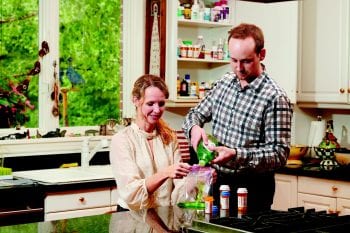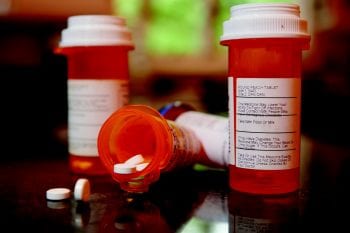Focus: Teach safe disposal of opioids

The term “drug crisis” traditionally evokes images of dealers selling to buyers they meet on the streets or behind closed doors. But in today’s opioid epidemic, the majority of drugs are not coming from strangers. The most recent U.S. Substance Abuse and Mental Health Administration survey found that about 70 percent of opioid users obtained their most recent supply from a friend or a relative’s left-over prescriptions.* It is this supply that the plastic surgery division is trying to combat through patient awareness efforts.
The first experience with an opioid for many people is with postsurgical pain management. But the pills often hang around long after the surgical pain has subsided. “We need to get these out of medicine cabinets so some teenager doesn’t experiment with them. And we need to do it in the proper manner,” says Division Chief Susan Mackinnon, the Sydney M. Jr. and Robert H. Shoenberg Chair in Plastic and Reconstructive Surgery.
A multidisciplinary team at Washington University studied the impact of a brochure instructing patients in the safe disposal of excess opioids. Results, published in the Journal of the American College of Surgeons,† found that 22 percent of patients receiving the brochure disposed of unused opioids, compared to 11 percent of those not receiving the brochure.
Mackinnon hopes her findings will alert patients to risks of leftover opioids for drug misuse and provide a simple way to help. Step 1 is to put unused opioids in a plastic bag; Step 2 is to mix them with dish detergent, which dissolves the drugs; step 3 is to throw the solution away. This provides a convenient alternative to finding a community medicine or pharmacy take-back event.
The Centers for Disease Control notes that in 2016, nearly two-thirds of the more than 63,000 drug overdose deaths in the United States involved an opioid. Declared a public health emergency, opioid addiction has an economic burden of $78.5 billion a year.††
“We can strive for a 100 percent disposal rate of excess opioids,” Mackinnon says.
*U.S. Department of Health and Services. Results from the 2012 National Survey on Drug Use and Health: Summary of National Findings.
†Hasak JM, Roth Bettlach CL, Santosa KB, Larson EL, Stroud J, Mackinnon SE. Empowering Post-Surgical Patients to Improve Opioid Disposal: A Before and After Quality Improvement Study. J Am Coll Surg. 2018 Mar;226(3):235-240.
††National Institute on Drug Abuse
Highlights

As part of an opioid project at St. Louis Children’s Hospital, pediatric plastic surgeons Alison Snyder-Warwick, MD, and Kamlesh Patel, MD, are evaluating the presence of opioids in the home before and after surgery as well as family opioid disposal practices in order to find ways to educate families and eliminate easy access to opioids. The issue is critical. Last year, 35.8 percent of U.S. 12th graders believed opioids were easily accessible. In 2016, 3.6 percent of U.S. adolescents reported inappropriately using prescription opioids in the prior year.*
The Division of Plastic Surgery also has begun a resident opioid education program after trainees were found to prescribe higher doses and more potent opioid medications than their Canadian counterparts. A study, which compared prescribing practices of plastic surgery residents here and at two universities in Canada, noted a wide range of resident prescribing habits for common plastic surgery procedures along with a lack of formal training in opioid prescribing among all three programs.
Plastic surgery residents and fellows successfully piloted a web-based communications platform called AMiON.com after surveys of primary nursing divisions found that 45 percent of nurses routinely made multiple phone calls before reaching the right resident. The system provides subspecialty contact information, enabling nurses to make direct calls to a specific resident rather than a general pager. The result was improved communications and a recommendation for continued use. Results were presented at the Department of Surgery’s Fourth Annual Patient Safety and Clinical Effectiveness Symposium.
*U.S. Department of Health and Human Services